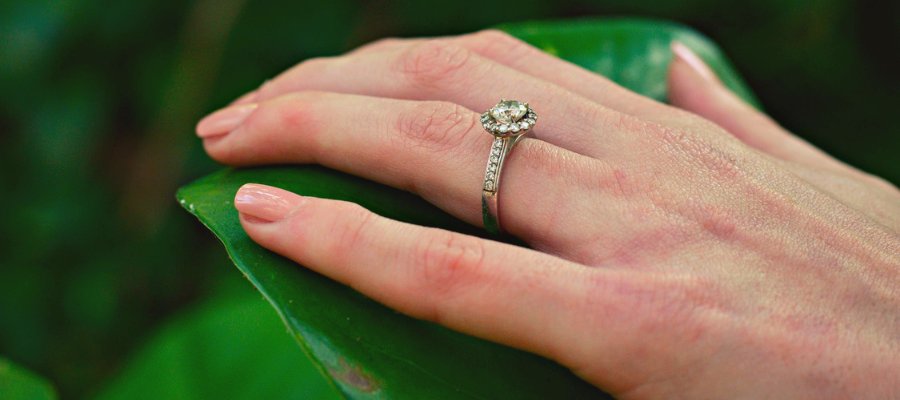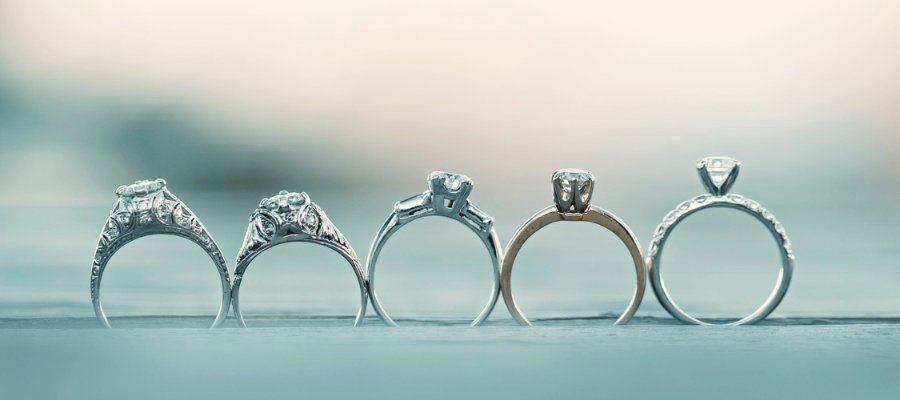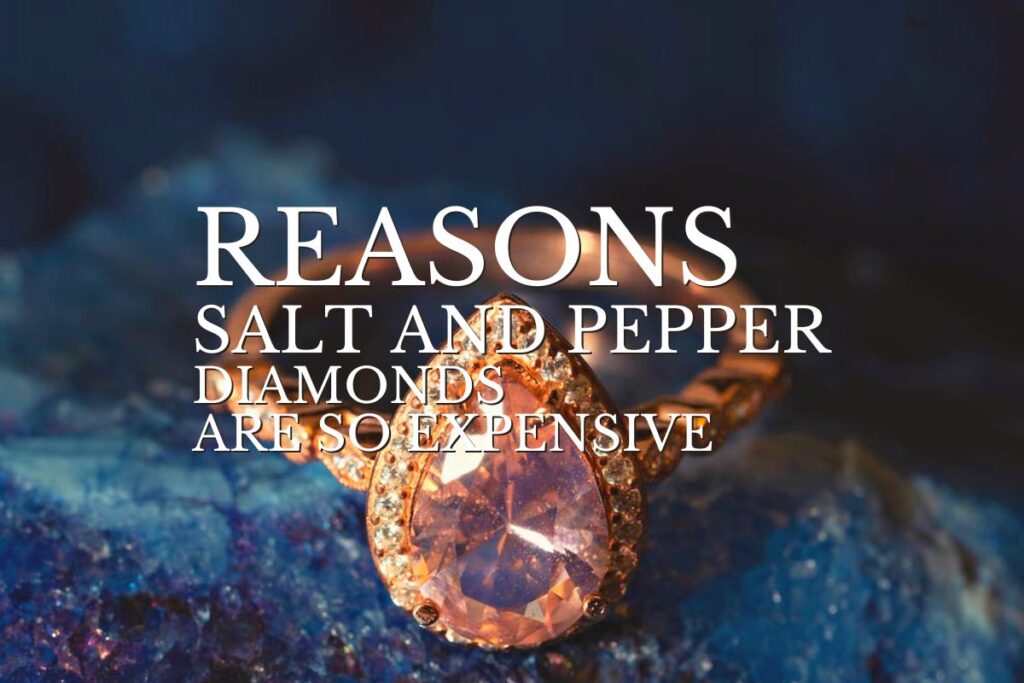When picking a gemstone for a piece of jewelry or a ring, many people are drawn to shiny white diamonds. However, these stones are often costly. Salt and pepper diamonds are increasing in popularity because of their lower price tag, but they can still be quite expensive.
Salt and pepper diamonds are expensive because demand for them is increasing, they’re rare gemstones, some have unique patterns that sell for more, and there is significant labor and skill involved in mining, sorting, and faceting them.
This article will explore all the reasons why salt and pepper diamonds can be so costly. Keep reading to learn what you need to know about these unique diamonds and their price.
1. The Demand Is Increasing

One of the primary reasons why the cost of salt and pepper diamonds is so high is that the price of these diamonds is market-driven. The stones have risen in popularity in recent years as a more affordable and unique alternative to a traditional white, clear diamond.
It’s not difficult to see why salt and pepper diamonds rose in popularity so quickly. Many couples appreciate the tradition and the beauty of diamond engagement rings, but diamond rings are often too expensive, especially if the couple has particular design requests and a certain number of carats they’d like.
Once people discovered they could pay a fraction of the price for a salt and pepper diamond, this option became very popular.
For example, a two-carat quality clear diamond ring usually costs over $10,000. A two-carat salt and pepper ring is usually around $4,000. For many couples, it is simply more realistic to spend $4,000 on a ring instead of over ten grand.
Additionally, clear diamonds are decreasing in popularity. In May 2022, diamond sales were down 24% from the previous year. It seems that consumers are not interested in paying the high prices for diamonds anymore, and alternatives such as lab-grown diamonds, salt and pepper diamonds, and other gemstones are becoming more common.
However, since more people are leaning towards salt and pepper diamonds, jewelers and jewelry stores can charge more for them because the demand is there.
If salt and pepper diamonds are still too expensive for your budget, you can consider another diamond alternative. The following table outlines the average price of various two-carat gems:
| Diamond Alternative | Average Cost of a Two-Carat Ring |
| Lab-Grown Diamond | $6,000 |
| Moissanite | $1,500 |
| Aquamarine | $1,350 |
| Sapphire | $3,000 |
| Amethyst | $1,200 |
| Emerald | $9,000 |
| Morganite | $3,300 |
| Ruby | $2,500 |
These stones are often more affordable than clear diamonds, and in the current market, they may be more affordable than salt and pepper diamonds, too.
However, the demand for salt and pepper diamonds isn’t only increasing because of the lower price tag. There are numerous other reasons why these diamonds are all the rage. Let’s take a look at some of them:
- They’re unique. Many people don’t want their ring to look identical to everyone else’s. No two salt and pepper diamonds look the same, and there are various interesting patterns and shapes the inclusions inside can take. It’s appealing for many to pick a completely unique diamond, just like their loved one.
- They go with everything. Some people are opposed to picking a colored gemstone, such as an aquamarine or sapphire, because of the color. While these gemstones are lovely, the color may cause them to clash with someone’s outfit, nails, or hair. However, people don’t have to worry about that with salt and pepper diamonds because they’re always a shade of gray or black, which goes with everything.
- They’re versatile. Jewelers can facet a salt and pepper diamond into almost any cut or shape, so not only can you get a unique diamond, but you can also easily custom-make a ring that expresses your loved one’s individuality and personality.
- Mining salt and pepper diamonds is more sustainable than diamonds. Because salt and pepper diamonds are more readily available than clear diamonds, it requires less effort and environmental destruction to uncover them. This makes them a more sustainable option for eco-conscious consumers.
- They’re durable. Salt and pepper diamonds have a 10 on the Mohs hardness scale, just like clear diamonds. You can wear a salt and pepper diamond ring every day and it most likely won’t get scratched or damaged. Unfortunately, they’re not as durable as clear diamonds because the inclusions can cause a break or a chip if you hit them extremely hard.
For the above reasons, the demand for salt and pepper diamonds is higher than it has ever been before. Therefore, the prices are higher too.
2. They Are Still Rare

Salt and pepper diamonds are less rare than clear diamonds, but it’s not as if you can start digging in your backyard and stumble across a bunch of them. These diamonds are still rare gemstones, which is reflected in their price.
Salt and pepper diamonds are mined throughout the globe, especially in Botswana, Russia, and Southeast Asia. The availability of salt and pepper diamonds is part of the reason they’re so affordable compared to clear diamonds, but they’re still costly because they’re not as readily available as other minerals, such as quartz.
3. More Unique Diamonds Are More Expensive

More and more people want jewelry to be an expression of their uniqueness and individuality, which is part of the reason why custom-made rings and clear diamond alternatives are becoming so popular. Because of this demand for uniqueness, jewelers and jewelry shops can charge more for salt and pepper diamonds with interesting designs.
Salt and pepper diamonds have various looks because of their many inclusions. Some are closer to black with white specks, and these so-called “galaxy” diamonds usually cost more because they’re so high in demand.
Other diamonds are dark or light gray, and some more closely resemble clear diamonds. The salt and pepper diamonds that closely resemble clear diamonds tend to cost more than their cousins with more inclusions.
4. Mining Diamonds Requires Effort and Labor

Although there are more salt and pepper diamonds available than clear diamonds, that doesn’t mean that the mining process for these stones is easy. If everyone involved is getting paid fairly for the hard labor associated with mining salt and pepper diamonds, the cost will be higher for the final product.
On average, a miner has to remove 250 tons (226,796 kg) of earth for just one carat of gem-quality salt and pepper diamond. There are four main types of diamond mining: alluvial, pit, underground, and marine. Let’s take a closer look at the labor that goes into each type of mining:
Alluvial Mining
Alluvial mining is the mining of stream bed deposits for diamonds. Miners can find diamonds in these areas because erosion, wind, rain, and water currents can wash diamonds from other deposits into these areas over time. Small-scale alluvial mining requires the miners to dig and sift through various materials using simple shovels or sieves.
Large-scale alluvial mining by mining companies is less common, though not unheard of. With this type of alluvial mining, the focus is on larger deposits, which can disrupt the area. Some larger-scale projects even divert entire rivers to reach diamonds.
Open-Pit Mining
Open-pit diamond mining involves removing layers of sand and rocks over the kimberlite. Kimberlite is a blue-tinged igneous rock that sometimes contains diamonds. Once the kimberlite is exposed, the mining company blasts the area to break up the ore. With just one blast, a company can break 3,000 tons (2,721,554 kg) of ore.
Then, the broken ore is transported to an ore crusher. There, the ore is sifted through and the diamonds are recovered.
Open-pit diamond mining is a huge undertaking, and often, all the workers involved with a specific project need to be flown into remote areas and housed. These efforts result in a higher price tag on all diamonds that come from the project.
Underground Mining
Underground diamond mining usually follows a successful open-pit mining expedition. Once the ore from the open-pit blast is no longer producing diamonds, a diamond company will drill shafts parallel to the kimberlite to exploit the full potential of a site. From these shafts, workers dig tunnels to transport all the underground kimberlite up and out of the site. This type of mining is even more expensive to operate than open-pit mining.
Marine Mining
Marine mining is the newest form of diamond mining, as it only became popular in the 1960s. Some diamonds were once swept off to the ocean by rivers, where they can be extracted with huge pumps connected to a mining vessel.
After the vessel sucks up the seabed, the water and sand are filtered to separate the diamonds from everything else. The acquisition and operation of these vessels are extremely expensive.
No matter how diamond ore is collected, it must go to a processing plant, where the ore is sorted and the diamonds are removed. The processing usually follows these steps:
- The rock goes through a crusher until it is broken down into small pieces.
- Occasionally, the rock must go through a secondary crusher to reduce its size even further.
- The ore undergoes the scrubbing process. During scrubbing, all minerals are separated from other materials by water.
- Any pieces under 1.5 mm are discarded. It is too difficult and too expensive to extract diamonds from ore this small.
- A ferrosilicon powder solution is added to the ore.
- The solution goes through a cyclone, which separates the minerals by density.
- The heaviest concentrate is separated and screened with magnetic fields.
- Diamonds are collected and cleaned.
- Clean diamonds are weighed and packaged.
Regardless of the type of mining employed to acquire the diamonds, there is a significant amount of work and labor involved throughout the process. If a salt and pepper diamond seems extremely cheap, you should inquire about the acquisition process before purchasing to determine if it was ethical or not.
5. Faceting and Designing Salt and Pepper Diamonds is Difficult

Just like with any other gemstone, it takes effort to facet a salt and pepper diamond into a specific cut or shape, and not everyone has the skill to do this job. Additionally, because some salt and pepper diamonds have such unique inclusions, it can be difficult for jewelers to create a ring design that suits the patterns within the stone.
To suit the inclusions in the stone, salt and pepper diamonds are usually made into fancy cuts, including step cuts, rose cuts, hexagons, kites, triangles, and pears. Let’s take a look at the pros and cons of each of these cuts:
| Type of Cut | Pros | Cons |
| Step | Highlights the unique inclusions within the stone Makes the stone look larger than it isSlims the finger Edges are smooth and won’t snag easily | Less brilliance than other cuts Prone to showing imperfections |
| Rose | Less expensive than other cuts Highlights unique inclusions in the stoneStone appears bigger than it is More unique cut | Less brilliance than other cuts Can accentuate flaws in the stone More difficult to quality control |
| Hexagon | Nontraditional, more unique Brings light into the center of the stone Looks good in various settings | Edges may dull over time Requires a durable setting Edges are prone to snagging More fragile |
| Kite | Lots of sparkleNontraditional, more unique Modern, contemporary look | Tip is prone to snagging Tip can break easily |
| Triangle | Modern, contemporary look Nontraditional, more unique More affordable than other cuts | Corners are delicate and may break easily Prone to snaggingDifficult to place in standard settings Low brilliance |
| Pear | Covers up any imperfections well Elongates the finger Shape is feminine and flatteringLess expensive than other cuts Great brilliance | Tip snags easily Tip can chip easily Difficult to find a high-quality pear cut diamond Difficult to find a symmetrical pear cut diamond |
Many hours of work go into every completed ring design, and that includes rings that feature salt and pepper diamonds. This makes for a higher price tag.


